#free online ebook designer
Text
Discover the World of Tommy Designs: Unique Creations, Inspired Artistry, and Endless Possibilities
At Tommy Designs, we believe in the power of creativity and self-expression. From graphic design to product creation, our mission is to offer something truly one-of-a-kind. Every design, every product, and every piece of content is crafted with passion, innovation, and an eye for detail. Whether you’re looking for custom-made apparel, home décor, or high-quality graphics, Tommy Designs has something for everyone.
A Fusion of Creativity and Craftsmanship
Tommy Designs is not just another online store. It’s the embodiment of creativity meeting craftsmanship. We take pride in offering unique, custom-designed products that stand out in both style and quality. Whether it's a custom graphic tee, a statement footwear piece, or home decor that brings your space to life, each item is designed to reflect personality, flair, and originality. We specialize in creating art that speaks—whether for everyday use or to mark a special occasion.
What sets us apart is our commitment to 100% originality. Every design is thoughtfully created, reflecting the latest trends, customer preferences, and of course, the unique vision that drives Tommy Designs. From custom apparel to beautifully designed footwear and decorative pieces, our goal is to ensure that every product is not only aesthetically pleasing but also durable, versatile, and practical.
A Designer’s Journey: Building Success without Paid Advertising
Tommy Designs proves that creativity and hard work can drive success without the need for paid ads. From the beginning, our business model has been built around organic growth, relying on engagement, SEO optimization, and building a genuine connection with our audience. We firmly believe that good content, high-quality products, and authentic customer relationships are the pillars of a thriving online business.
We focus on delivering exceptional customer experiences, original content in every design, and creating products that resonate with a wide range of audiences. Our brand has grown through social media engagement, blog posts, and word-of-mouth recommendations, rather than expensive marketing campaigns.
The Tommy Designs Shop: Where Art Meets Commerce
At the heart of Tommy Designs is our online store, which showcases an array of handcrafted products, including apparel, shoes, and home décor, all bearing our signature design aesthetic. Our collection ranges from trendy streetwear to elegant decor, ensuring there’s something for everyone. Whether you're looking for something edgy or chic, Tommy Designs has it all, with a personal touch.
But we don’t stop there. Our store is a place where we also showcase the work that goes into each product. Our portfolio of designs reflects the dedication, skill, and artistry behind every item. Customers can see firsthand how much effort and creativity go into creating the pieces they love.
Affiliate Marketing: A Trusted Side Hustle
In addition to our main shop, we are proud to engage in affiliate marketing—a side hustle that aligns perfectly with our brand. Through careful partnerships with trusted companies, we share exclusive deals and products that fit our aesthetic and mission. Our audience knows they can trust the recommendations we make because we only promote products we genuinely believe in. From fashion accessories to tech gadgets, Tommy Designs always brings you the best.
Engaging Content: From Blogs to Social Media
At Tommy Designs, it’s not just about the products. We believe in the importance of sharing knowledge and fostering community, which is why we actively engage in blogging and content creation. Our blog posts cover a wide range of topics, from design trends to insider tips on how to style our products. We also share our journey, offering valuable insights into running a successful e-commerce business without paid ads.
We maintain an active presence across social media platforms such as Instagram, Pinterest, and Facebook, where we share our latest designs, exclusive discounts, and more. It’s a place where our followers can interact with us directly, giving feedback and staying updated on what’s new.
Services and Custom Design Options
Looking for custom design services? We’ve got you covered. Tommy Designs offers personalized graphics and apparel, giving you the chance to bring your own ideas to life. Whether it’s for a business, special event, or personal use, our team is here to help craft the perfect design that fits your needs.
Additionally, we provide photo manipulation services, ensuring that your images are enhanced to their full potential. From simple touch-ups to more advanced edits, our skilled graphic designers can handle it all. These services set us apart, as we combine art with technology to deliver results that exceed expectations.
Customer-Centered Focus
Customer satisfaction is our top priority. Whether you're buying from our shop, engaging with our blog, or seeking our design services, we ensure that every experience with Tommy Designs is seamless and enjoyable. We offer clear communication channels, including a comprehensive FAQ section, detailed product descriptions, and a responsive contact us form. Whatever you need, we’re here to help.
The Future of Tommy Designs
As we continue to grow, our commitment to offering high-quality, unique products remains the same. We aim to keep pushing the boundaries of creativity and innovation, all while providing an outstanding customer experience. Keep an eye out for new collections, exciting blog posts, and maybe even a few surprises along the way.
Tommy Designs is more than just a brand; it’s a community where creativity thrives and individuality shines. We invite you to explore our store, follow our journey, and join us in celebrating the beauty of art, fashion, and design.
Join the Tommy Designs Community Today!
Explore our store and discover the creative world of Tommy Designs by visiting Tommy Designs Store. Whether you’re looking for custom products or just inspiration, we’ve got something for you!
Heres all of our links support a small business by following and sharing please.
All Links - BIO - Shop
Amazon Author Profile - Please Follow
Facebook Page
Facebook Group
Instagram
@Threads
TikTok - Shop + Profile
Pinterest
Youtube - Subscribe
X Profile
Designhill Services + Art
Bluesky Social Profile
Shop Art & Products Designs by Tommy Designs
Artstation Profile
LinkedIN
Twitch - Drop us a follow
Throne - Support Streamers /w Gifts
LINK IN BIO + STORE
Printify Clothing store by Tommy Designs
Blogs
FAQs Page on Website
Sign up for Newsletter from our store
From Fields to Pixels - Biography | Kindle Vella (amazon.com)
#amazon author#amazon kindle#amazon#kindle unlimited#author#diy projects#diy craft#diy#motivation#ebookdeals#kindle ebooks#free ebooks#important#growth#mindset#fashion statement#creative expression#creativity unleashed#fashion#clothing shop online#home decor#graphics#apparel#personal growth#personal development#resilience#growth mindset#positive mental attitude#everyone#tommy designs
0 notes
Text
How to Make Money Online with DigiVault’s All-in-1 Bundle
Unlock the potential of DigiVault’s All-in-1 Bundle and start making money online today! Learn how to resell digital products, offer services, and grow your brand with our comprehensive guide. Dive in now! #MakeMoneyOnline #DigitalProducts #DigiVault
In the modern digital age, the opportunities to make money online are vast and varied. Whether you’re a budding entrepreneur, a seasoned business professional, or someone looking to generate passive income, digital products offer a profitable and scalable avenue. DigiVault, with its extensive range of digital resources, stands out as a premier platform for acquiring high-quality digital products…

View On WordPress
#All-in-1 Bundle#digital marketing#digital services#DigiVault#eBooks#graphic design#make money online#Online business#personal branding#PLR articles#resell digital products#royalty-free music#social media templates#video courses
1 note
·
View note
Text
Inkjump Linkdump

For the rest of May, my bestselling solarpunk utopian novel THE LOST CAUSE (2023) is available as a $2.99, DRM-free ebook!

It's the start of a long weekend and I've found myself with a backlog of links, so it's time for another linkdump – the eighteenth in the (occasional) series. Here's the previous installments:
https://pluralistic.net/tag/linkdump/
Kicking off this week's backlog is a piece of epic lawyer-snark, which is something I always love, but what makes this snark total catnip for me is that it's snark about copyfraud: false copyright claims made to censor online speech. Yes please and a second portion, thank you very much!
This starts with the Cola Corporation, a radical LA-based design store that makes lefty t-shirts, stickers and the like. Cola made a t-shirt that remixed the LA Lakers logo to read "Fuck the LAPD." In response, the LAPD's private foundation sent a nonsense copyright takedown letter. Cola's lawyer, Mike Dunford, sent them a chef's-kiss-perfect reply, just two words long: "LOL, no":
https://www.techdirt.com/2024/04/19/apparel-company-gives-perfect-response-to-lapds-nonsense-ip-threat-letter-over-fuck-the-lapd-shirt/
But that's not the lawyer snark I'm writing about today. Dunford also sent a letter to IMG Worldwide, whose lawyers sent the initial threat, demanding an explanation for this outrageous threat, which was – as the physicists say – "not even wrong":
https://www.loweringthebar.net/2024/05/lol-no-explained.html
Every part of the legal threat is dissected here, with lavish, caustic footnotes, mercilessly picking apart the legal defects, including legally actionable copyfraud under DMCA 512(f), which provides for penalties for wrongful copyright threats. To my delight, Dunford cited Lenz here, which is the infamous "Dancing Baby" case that EFF successfully litigated on behalf of Stephanie Lenz, whose video of her adorable (then-)toddler dancing to a few seconds of Prince's "Let's Go Crazy" was censored by Universal Music Group:
https://www.eff.org/cases/lenz-v-universal
Dunford's towering rage is leavened with incredulous demands for explanations: how on Earth could a lawyer knowingly send such a defective, illegal threat? Why shouldn't Dunford seek recovery of his costs from IMG and its client, the LA Police Foundation, for such lawless bullying? It is a sparkling – incandescent, even! – piece of lawyerly writing. If only all legal correspondence was this entertaining! Every 1L should study this.
Meanwhile, Cola has sold out of everything, thanks to that viral "LOL, no." initial response letter. They're taking orders for their next resupply, shipping on June 1. Gotta love that Streisand Effect!
https://www.thecolacorporation.com/
I'm generally skeptical of political activism that takes the form of buying things or refusing to do so. "Voting with your wallet" is a pretty difficult trick to pull off. After all, the people with the thickest wallets get the most votes, and generally, the monopoly party wins. But as the Cola Company's example shows, there's times when shopping can be a political act.
But that's because it's a collective act. Lots of us went and bought stuff from Cola, to send a message to the LAPD about legal bullying. That kind of collective action is hard to pull off, especially when it comes to purchase-decisions. Often, this kind of thing descends into a kind of parody of political action, where you substitute shopping for ideology. This is where Matt Bors's Mr Gotcha comes in: "ooh, you want to make things better, but you bought a product from a tainted company, I guess you're not really sincere, gotcha!"
https://thenib.com/mister-gotcha/
There's a great example of this in Zephyr Teachout's brilliant 2020 book Break 'Em Up: if you miss the pro-union demonstration at the Amazon warehouse because you spent two hours driving around looking for an indie stationer to buy the cardboard to make your protest sign rather than buying it from Amazon, Amazon wins:
https://pluralistic.net/2020/07/29/break-em-up/#break-em-up
So yeah, I'm pretty skeptical of consumerism as a framework for political activism. It's very hard to pull off an effective boycott, especially of a monopolist. But if you can pull it off, well…
Canada is one of the most monopoly-friendly countries in the world. Hell, the Competition Act doesn't even have an "abuse of dominance" standard! That's like a criminal code that doesn't have a section prohibiting "murder." (The Trudeau government has promised to fix this.)
https://www.theglobeandmail.com/opinion/editorials/article-an-overhauled-competition-act-will-light-a-fire-in-the-stolid-world-of/
There's stiff competition for Most Guillotineable Canadian Billionaire. There's the entire Irving family, who basically own the province of New Bruinswick:
https://www.canadaland.com/podcast/dynasties-2-the-irvings/
There's Ted Rogers, the trumpy billionaire telecoms monopolist, whose serial acquire-and-loot approach to media has devastated Canadian TV and publishing:
https://www.canadaland.com/podcast/canadaland-725-the-rogers-family-compact/
But then there's Galen Fucking Weston, the nepobaby who inherited the family grocery business (including Loblaw), bought out all his competitors (including Shopper's Drug Mart), and then engaged in a criminal price-fixing conspiracy to rig the price of bread, the most Les-Miz-ass crime imaginable:
https://www.blogto.com/eat_drink/2023/06/what-should-happened-galen-weston-price-fixing/
Weston has made himself the face of the family business, appearing in TV ads in a cardigan to deliver dead-eyed avuncular paeans to his sprawling empire, even as he colludes with competitors to rig the price of his workers' wages:
https://www.bloomberg.com/news/articles/2020-06-12/a-supermarket-billionaire-steps-into-trouble-over-pandemic-wages
For Canadians, Weston is the face of greedflation, the man whose nickle-and-diming knows no shame. This is the man who decided that the discount on nearly-spoiled produce would be slashed from 50% to 30%, who racked up record profits even as his prices skyrocketed.
It's impossible to overstate how loathed Galen Weston is at this moment. There's a very good episode of the excellent new podcast Lately, hosted by Canadian competition expert Vass Bednar and Katrina Onstad that gives you a sense of the national outrage:
https://www.theglobeandmail.com/podcasts/lately/article-boycotting-the-loblawpoly/
All of this has led to a national boycott of Loblaw, kicked off by members of the r/loblawsisoutofcontrol, and it's working. Writing for Jacobin, Jeremy Appel gives us a snapshot of a nation in revolt:
https://jacobin.com/2024/05/loblaw-grocery-price-gouge-boycott/
Appel points out the boycott's problems – there's lots of places, particularly in the north, where Loblaw's is the only game in town, or where the sole competitor is the equally odious Walmart. But he also talks about the beneficial effect the boycott is having for independent grocers and co-ops who deal more fairly with their suppliers and their customers.
He also platforms the boycott's call for a national system of price controls on certain staples. This is something that neoliberal economists despise, and it's always fun to watch them lose their minds when the subject is raised. Meanwhile, economists like Isabella M Weber continue to publish careful research explaining how and why price controls can work, and represent our best weapon against "seller's inflation":
https://scholarworks.umass.edu/econ_workingpaper/343/
Antimonopoly sentiment is having a minute, obviously, and the news comes at you fast. This week, the DoJ filed a lawsuit to break up Ticketmaster/Live Nation, one of the country's most notorious monopolists, who have aroused the ire of every kind of fan, but especially the Swifties (don't fuck with Swifties). In announcing the suit, DoJ Antitrust Division boss Jonathan Kanter coined the term "Ticketmaster tax" to describe the junk fees that Ticketmaster uses to pick all our pockets.
In response, Ticketmaster has mobilized its own Loblaw-like shill army, who insist that all the anti-monopoly activism is misguided populism, and "anti-business." In his BIG newsletter, Matt Stoller tears these claims apart, and provides one of the clearest explanations of how Ticketmaster rips us all off that I've ever seen, leaning heavily on Ticketmaster's own statements to their investors and the business-press:
https://www.thebignewsletter.com/p/antitrust-enforcers-to-break-up-ticketmaster
Ticketmaster has a complicated "flywheel" that it uses to corner the market on live events, mixing low-margin businesses that are deliberately kept unprofitable (to prevent competitors from gaining a foothold) in order to capture the high-margin businesses that are its real prize. All this complexity can make your eyes glaze over, and that's to Ticketmaster's benefit, keeping normies from looking too closely at how this bizarre self-licking ice-cream cone really works.
But for industry insiders, those workings are all too clear. When Rebecca Giblin and I were working on our book Chokepoint Capitalism, we talked to insiders from every corner of the entertainment-industrial complex, and there was always at least one expert who'd go on record about the scams inside everything from news monopolies to streaming video to publishing and the record industry:
https://chokepointcapitalism.com/
The sole exception was Ticketmaster/Live Nation. When we talked to club owners, promoters and other victims of TM's scam, they universally refused to go on the record. They were palpably terrified of retaliation from Ticketmaster's enforcers. They acted like mafia informants seeking witness protection. Not without reason, mind you: back when the TM monopoly was just getting started, Pearl Jam – then one of the most powerful acts in American music – took a stand against them. Ticketmaster destroyed them. That was when TM was a mere hatchling, with a bare fraction of the terrifying power it wields today.
TM is a great example of the problem with boycotts. If a club or an act refuses to work with TM/LN, they're destroyed. If a fan refuses to buy tickets from TM or see a Live Nation show, they basically can't go to any shows. The TM monopoly isn't a problem of bad individual choices – it's a systemic problem that needs a systemic response.
That's what makes antitrust responses so timely. Federal enforcers have wide-ranging powers, and can seek remedies that consumerism can never attain – there's no way a boycott could result in a breakup of Ticketmaster/Live Nation, but a DoJ lawsuit can absolutely get there.
Every federal agency has wide-ranging antimonopoly powers at its disposal. These are laid out very well in Tim Wu's 2020 White House Executive Order on competition, which identifies 72 ways the agencies can act against monopoly without having to wait for Congress:
https://pluralistic.net/2021/08/13/post-bork-era/#manne-down
But of course, the majority of antimonopoly power is vested in the FTC, the agency created to police corporate power. Section 5 of the FTC Act grants the agency the power to act to prevent "unfair and deceptive methods of competition":
https://pluralistic.net/2023/01/10/the-courage-to-govern/#whos-in-charge
This clause has lain largely dormant since the Reagan era, but FTC chair Lina Khan has revived it, using it to create muscular privacy rights for Americans, and to ban noncompete agreements that bind American workers to dead-end jobs:
https://pluralistic.net/2024/04/25/capri-v-tapestry/#aiming-at-dollars-not-men
The FTC's power to ban activity because it's "unfair and deceptive" is exciting, because it promises American internet users a way to solve their problems beyond copyright law. Copyright law is basically the only law that survived the digital transition, even as privacy, labor and consumer protection rights went into hibernation. The last time Congress gave us a federal consumer privacy law was 1988, and it's a law that bans video store clerks from telling the newspapers which VHS cassettes you rented:
https://en.wikipedia.org/wiki/Video_Privacy_Protection_Act
That's left internet users desperately trying to contort copyright to solve every problem they have – like someone trying to build a house using nothing but chainsaw. For example, I once found someone impersonating me on a dating site, luring strangers into private spaces. Alarmed, I contacted the dating site, who told me that their only fix for this was for me to file a copyright claim against the impersonator to make them remove the profile photo. Now, that photo was Creative Commons licensed, so any takedown notice would have been a "LOL, no." grade act of copyfraud:
https://pluralistic.net/2023/10/21/the-internets-original-sin/
The unsuitability of copyright for solving complex labor and privacy problems hasn't stopped people who experience these problems from trying to use copyright to solve them. They've got nothing else, after all.
That's why everyone who's worried about the absolutely legitimate and urgent concerns over AI and labor and privacy has latched onto copyright as the best tool for resolving these questions, despite copyright's total unsuitability for this purpose, and the strong likelihood that this will make these problems worse:
https://pluralistic.net/2024/05/13/spooky-action-at-a-close-up/#invisible-hand
Enter FTC Chair Lina Khan, who has just announced that her agency will be reviewing AI model training as an "unfair and deceptive method of competition":
https://thehill.com/policy/technology/4682461-ftc-chair-ai-models-could-violate-antitrust-laws/
If the agency can establish this fact, they will have sweeping powers to craft rules prohibiting the destructive and unfair uses of AI, without endangering beneficial activities like scraping, mathematical analysis, and the creation of automated systems that help with everything from adding archival metadata to exonerating wrongly convicted people rotting in prison:
https://hrdag.org/tech-notes/large-language-models-IPNO.html
I love this so much. Khan's announcement accomplishes the seemingly impossible: affirming that there are real problems and insisting that we employ tactics that can actually fix those problems, rather than just doing something because inaction is so frustrating.
That's something we could use a lot more of, especially in platform regulation. The other big tech news about Big Tech last week was the progress of a bill that would repeal Section 230 of the Communications Decency Act at the end of 2025, without any plans to replace it with something else.
Section 230 is the most maligned, least understood internet law, and that's saying something:
https://www.techdirt.com/2020/06/23/hello-youve-been-referred-here-because-youre-wrong-about-section-230-communications-decency-act/
Its critics wrongly accuse the law – which makes internet users liable for bad speech acts, not the platforms that carry that speech – of being a gift to Big Tech. That's totally wrong. Without Section 230, platforms could be named to lawsuits arising from their users' actions. We know how that would play out.
Back in 2018, Congress took a big chunk out of 230 when they passed SESTA/FOSTA, a law that makes platforms liable for any sex trafficking that is facilitated by their platforms. Now, this may sound like a narrowly targeted, beneficial law that aims at a deplorable, unconscionable crime. But here's how it played out: the platforms decided that it was too much trouble to distinguish sex trafficking from any sex-work, including consensual sex work and adjacent activities. The result? Consensual sex-work became infinitely more dangerous and precarious, while trafficking was largely unaffected:
https://www.gao.gov/assets/gao-21-385.pdf
Eliminating 230 would be incredibly reckless under any circumstances, but after the SESTA/FOSTA experience, it's unforgivable. The Big Tech platforms will greet this development by indiscriminately wiping out any kind of controversial speech from marginalized groups (think #MeToo or Black Lives Matter). Meanwhile, the rich and powerful will get a new tool – far more powerful than copyfraud – to make inconvenient speech disappear. The war-criminals, rapists, murderers and rip-off artists who currently make do with bogus copyright claims to "manage their reputations" will be able to use pretextual legal threats to make their critics just disappear:
https://www.qurium.org/forensics/dark-ops-undercovered-episode-i-eliminalia/
In a post-230 world, Cola Corporation's lawyers wouldn't get a chance to reply to the LAPD's bullying lawyers – those lawyers would send their letter to Cola's hosting provider, who would weigh the possibility of being named in a lawsuit against the small-dollar monthly payment they get from Cola, and poof, no more Cola. The legal bullies could do the same for Cola's email provider, their payment processor, their anti-DoS provider.
This week on EFF's Deeplinks blog, I published a piece making the connection between abolishing Section 230 and reinforcing Big Tech monopolies:
https://www.eff.org/deeplinks/2024/05/wanna-make-big-tech-monopolies-even-worse-kill-section-230
The Big Tech platforms really do suck, and the solution to their systemic, persistent moderation failures won't come from making them liable for users' speech. The platforms have correctly assessed that they alone have the legal and moderation staff to do the kinds of mass-deletions of controversial speech that could survive a post-230 world. That's why tech billionaires like Mark Zuckerberg love the idea of getting rid of 230:
https://www.eff.org/deeplinks/2021/03/facebooks-pitch-congress-section-230-me-not-thee
But for small tech providers – individuals, co-ops, nonprofits and startups that host fediverse servers, standalone group chats and BBSes – a post-230 world is a mass-extinction event. Ever had a friend demand that you take sides in an interpersonal dispute ("if you invite her to the party, I'm not coming!").
Imagine if your refusal to take sides in a dispute among your friends – and their friends, and their friends – could result in you being named to a suit that could cost hundreds of thousands of dollars to settle:
https://www.engine.is/news/primer/section230costs
It's one thing to hope for a more humane internet run by people who want to make hospitable forums for online communities to form. It's another to ask them to take on an uninsurable risk that could result in the loss of their home, their retirement account, and their life's savings.
A post-230 world is one in which Big Tech must delete first and ask questions later. Yes, Big Tech platforms have many sins to answer for, but making them jointly liable for their users' speech will flush out treasure-hunters seeking a quick settlement and a quick buck.
Again, this isn't speculative – it's inevitable. Consider FTX: yes, the disgraced cryptocurrency exchange was a festering hive of fraud – but there's no way that fraud added up to the 23.6 quintillion dollars in claims that have been laid against it:
https://cdn.arstechnica.net/wp-content/uploads/2024/03/US-v-SBF-Alameda-Research-Victim-Impact-Statement-3-20-2024.pdf
Without 230, Big Tech will shut down anything controversial – and small tech will disappear. It's the worst of all possible worlds, a gift to tech monopolists and the bullies and crooks who have turned our online communities into shooting galleries.
One of the reasons I love working for EFF is our ability to propose technologically informed, sound policy solutions to the very real problems that tech creates, such as our work on interoperability as a way to make it easier for users to escape Big Tech:
https://www.eff.org/interoperablefacebook
Every year, EFF recognizes the best, bravest and brightest contributors to a better internet and a better technological future, with our annual EFF Awards. Nominations just opened for this year's awards – if you know someone who fits the bill, here's the form:
https://www.eff.org/nominations-open-2024-eff-awards
It's nearly time for me to sign off on this weekend's linkdump. For one thing, I have to vacate my backyard hammock, because we've got contractors who need to access the side of the house to install our brand new heat-pump (one of two things I'm purchasing with my last lump-sum book advance – the other is corrective cataract surgery that will give me lifelong, perfect vision).
I've been lusting after a heat-pump for years, and they just keep getting better – though you might not know it, thanks to the fossil-fuel industry disinfo campaign that insists that these unbelievably cool gadgets don't work. This week in Wired, Matt Simon offers a comprehensive debunking of this nonsense, and on the way, explains the nearly magical technology that allows a heat pump to heat a midwestern home in the dead of winter:
https://www.wired.com/story/myth-heat-pumps-cold-weather-freezing-subzero/
As heat pumps become more common, their applications will continue to proliferate. On Bloomberg, Feargus O'Sullivan describes one such application: the Japanese yokushitsu kansouki – a sealed bathroom with its own heat-pump that can perfectly dry all your clothes while you're out at work:
https://www.bloomberg.com/news/articles/2024-05-22/laundry-lessons-from-japanese-bathroom-technology
This is amazing stuff – it uses less energy than a clothes-dryer, leaves your clothes wrinkle-free, prevents the rapid deterioration caused by high heat and mechanical agitation, and prevents the microfiber pollution that lowers our air-quality.
This is the most solarpunk thing I've read all week, and it makes me insanely jealous of Japanese people. The second-most solarpunk thing I've read this week came from The New Republic, where Aaron Regunberg and Donald Braman discuss the possibility of using civil asset forfeiture laws – lately expanded to farcical levels by the Supreme Court in Culley – to force the fossil fuel industry to pay for the energy transition:
https://newrepublic.com/article/181721/fossil-fuels-civil-forefeiture-pipeline-climate
They point out that the fossil fuel industry has committed a string of undisputed crimes, including fraud, and that the Supremes' new standard for asset forfeiture could comfortably accommodate state AGs and other enforcers who seek billions from Big Oil on this basis. Of course, Big Oil has more resources to fight civil asset forfeiture than the median disputant in these cases ("a low- or moderate-income person of color [with] a suspected connection to drugs"). But it's an exciting idea!
All right, the heat-pump guys really need me to vacate the hammock, so here's one last quickie for you: Barath Raghavan and Bruce Schneier's new paper, "Seeing Like a Data Structure":
https://www.belfercenter.org/publication/seeing-data-structure
This is a masterful riff on James C Scott's classic Seeing Like a State, and it describes how digitalization forces us into computable categories, and counts the real costs of doing so. It's a gnarly and thoughtful piece, and it's been on my mind continuously since Schneier sent it to me yesterday. Something suitably chewy for you to masticate over the long weekend!

If you'd like an essay-formatted version of this post to read or share, here's a link to it on pluralistic.net, my surveillance-free, ad-free, tracker-free blog:
https://pluralistic.net/2024/05/25/anthology/#lol-no
#pluralistic#lol no#censorship#slapp#lapd#cola#canada#loblaws#guillotine watch#galen weston#vass bednar#podcasts#linkdump#linkdumps#eff#eff awards#trustbusting#monopolies#livenation#ticketmaster#ticketmaster tax#cda 230#section 230#communications decency act#fediverse#lina khan#ai#ftc
145 notes
·
View notes
Text
My theory — and I want to stress this — exclusive to Netherworld Post stories is they should be free to read. Easily and widely.
They are simple (we don’t have a professional editor), they are short, they can be hosted on a site that is paid for anyway (the shop).
So it costs little to make and nothing to share.
They are (I hope) very enjoyable.
I have longed to build something like this since 2007. @evilsupplyco stories are the base and they will exist on Tumblr until the site shuts down or does something super egregious.
But this site is a social media platform.
It’s not designed for stories or reading consecutive adventures or characters growing.
I call them “coffee cup stories” because they are designed to be read, in entirety and maybe a few at a time, over about a cup of coffee or so.
The idea began in 2007 and I pitched it and no one would fund it and I eventually gathered the resources to launch @evilsupplyco in 2012 and then ran that for nearly a decade.
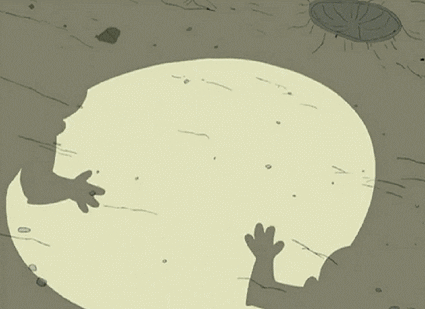
Then paused (traffic accident, Covid, rebuild)

Now we are back. And it’s great.
The shop is open.
The stories are gathering.
There will never be a pay wall or log in to read.
They will be posted once I hammer out a giant knot of tech.
As they gather up online, there will be booklets and ebooks. Part of this stage is ensuring they are inexpensive to you and profitable to me and high quality in production.
All things are a bit slower to ship (several days to leave our docks) than other shops, but this slowness makes our production cost much lower, making our retail price very low.
Ship slow, prices low, quality high, themes wide.
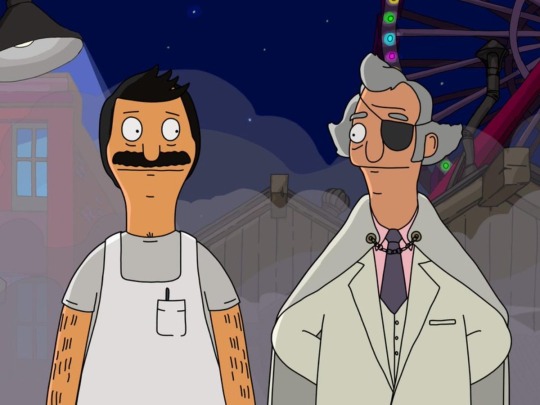
Thank you for your attention.
It’s back to work.
53 notes
·
View notes
Note
hi! I've always admired how you include infrastructure systems in your worldbuilding, and I was wondering if you have any book/documentary/podcast/etc. recs for someone who wants to go into gnarly detail about (for example) wastewater processing, O2 production, and simulated weather systems on a generation ship, but whose current level of knowledge is just "I read a lot of sci-fi?" I find the stuff fascinating in other people's writing, but figuring out where to start research is overwhelming.
shit, that's tough. most of my qualifications are 'i also read a lot of sci fi' but i also read a lot of those pop-up pocket news articles about technology and the environment... my brain isn't one of those kinds of brains where there's much differentiation between what im reading, what im writing, and who im in conversation with. im just always reading everything and having opinions on it and telling my friends what i just learned and learning more about what they learned and so on... tumblr's great for that, honestly. follow a lot of environment and good news blogs, and you'll get an interesting feed of interesting updates on the global ecology.
i would also suggest browsing national geographic, wired, and make magazine websites, if you can. get some good paywall blockers, or dish out for a subscription... the atlantic also has interesting stuff here and there.
'how it's made' type videos are great, especially older mr rogers era stuff, where the machines are less digital and more manual.
get a library card, especially for ebooks--if you're american you can use libby--and browse nonfiction. you can also just ask librarians to help you find stuff. i really admire science writers mary roach and randall munroe, think ryan north is very entertaining, and find malcom gladwell and bill bryson interesting if not particularly trustworthy.
hope this helps! i don't have any more specific suggestions, sorry.
EDIT: GET DUCK DUCK GO AS YOUR SEARCH ENGINE AND FIREFOX WITH UBLOCK AS YOUR BROWSER. i can't emphasize enough how much more useful your search results will be when you need to learn real information about things like ships and sewage systems and oyster farming. these days google only sends you to amazon, wayfair, and pinterest, it's fucking useless if you're not shopping, and sucks even if you are shopping.
there's other, more specialized browsers too that are worth a look.
and of course the internet archive has the wayback machine plus a lot of cool old books for free:
edit edit: here's another post on good search engines
138 notes
·
View notes
Note
About your recent post where you said you’re willing to talk to new writers: I’m very secure about the quality of my actual writing, but it’s the looming, impenetrable crucible of publishing that utterly defeats me. How did you do it? Could you possibly offer me any help in that regard?
Hi! Publishing is not nearly as intimidating or as scary as you think it is, or as people seem to make it out to be. I've never trad pubbed a novel, but I have self published and published short stories in professional journals, as well as worked as a columnist in an arts website.
For self publishing I bought an ISBN, but I don't think you have to in the US since you can get free ones from Ingram Spark and Amazon. People say Ingram Spark is difficult to navigate but honestly skill issue because once you learn how to use it it's way more convenient - plus the formatting is infinitely better. I downloaded my Ingram Spark ebook and used it as the file for Amazon because the Kindle book making software is mid at best.
Anyways you import your book, set prices to calculate royalties - it's a little extra on Amazon if you want extended distribution and for it to get in libraries, which is why I sprung for my own ISBN. It was like 140 bucks I think, maybe less. Then you design a cover - Canva is cool and free, it doesn't need to be crazy, minimalism is timeless. Approve all of it, maybe order a proof copy to make sure it looks groovy. Then you approve it and in like a week your books are available online.
Amazon has Amazon, obviously, but Ingram Sparks has a direct link you can share for people to buy. It also helps when you're working with bookstores, which I still have to do, because they can just buy from them directly. They just look up your ISBN code.
Uh, and for short stories you can just look up lit mags that publish in the genre you write in. If I write body horror, Id say "body horror short story submissions (month, year)" and then just send it to anyone whose requirements you meet. Some don't pay but that's fine, I think. It's just cool to get out there and have an online portfolio.
It's really just a tedious kind of numbers thing, like a household chore for writers. And yeah it hurts at first when you get rejected. But after a while you start getting rejections from places you don't remember submitting to and you're just kind of like "huh okay".
That's my main publishing takes. I have separate experience in producing plays that I've written and culture/technical writing (which is really fun if you find a good gig), but I dont think that's relevant for the average prose writer haha. But yeah get submitting, it can't hurt!
Oh marketing, though. That's the scary part. Publishings nothing compared to the existential horror of marketing yourself. But you can worry about that later.
11 notes
·
View notes
Text

BYOB: Be Your Own Boss
Ready to break free from the 9-to-5 grind? Being your own boss isn’t just a dream—it’s a reality waiting to happen. For melanin creators, the digital marketing space offers endless opportunities to take control of your financial future.
Digital marketing diversity is the key to unlocking success. Whether it’s through creating digital products that educate and uplift the melanin community, or leveraging the power of affiliate marketing, there’s a space for you to thrive. The growth of digital marketing means more chances to showcase your unique voice and create a lasting impact.
From ebooks to online courses, top-selling digital products are transforming how melanin creators make their mark. Not only do these products generate income, but they also empower others in our community to rise and succeed. The impact of digital and affiliate marketing is undeniable, and it's time to tap into that potential.
Start your journey to becoming your own boss today. Explore our range of digital products, affiliate opportunities, and print-on-demand items designed to elevate your brand and boost your business. Visit our website and take the first step towards financial freedom!
#melanin#affiliate marketing for melanin creators#digital products for melanin creators#digital marketing for melanin creators#melanin digital marketing#melanincontent#melaninentrepreneur#melanincreators
5 notes
·
View notes
Text
Me vs the bookmark alignment chart:

Lawful Good:
For a start, if books all came with ribbons, we’d be using ribbons. Ribbons create lawful good. They’re a form of free will removal. Thus, I’d argue that ribbons are evil.
If I ever publish a book I am going to lobby for there to be ribbons in the hardback version (because you just can’t get them in paperback). Not because I want everyone to be lawful good, but because ribbons are elegant. And practical. Evil geniuses would have books with ribbons.
But hardbacks themselves are impractical. One day I shall write a treatise about the death of morality being caused by the fall in popularity of the hardback book.
Neutral Good:
I have never met anyone who uses a sentence pointer. I have never even seen a sentence pointer. And I used to be an English teacher. If you seek out one of these I would argue that you are not neutral about it. You are passionately engaged.
Chaotic Good:
This seem accurate. Most people are chaotic these days. Who has time to be so organised you remember to bring your bookmark with you in case you find a book you like? Scraps and ephemera from your life being recycled in this way is certainly good, definitely chaotic. Deeply personal.
I used to be like this but then I stopped going out and started shopping online and now my child steals my receipts, which are always from the library, to draw on. Insert pithy quote about the downfall of society here.
Lawful Neutral:
Having some books as only ebooks is totally fine, though personally it does incur in me a panic that I have not held said book physically in my hands or have it physically manifested on a shelf for me to look at. That said, my E-reader is on a bookshelf, like a proper book.
I’m not neutral about this.
True Neutral:
A proper bookmark. Good grief.
I have tried this. When I was younger, I had a collection of beautiful bookmarks, some practical, some completely impractical, covered in beads and nonsense like they were designed by people who had never seen how a book works.
To own bookmarks is to be a slave to bookmarks.
I occasionally find my old bookmarks when emptying boxes I haven’t opened since a house move, or in a shelved book I can’t remember reading. I would love to be a ‘bookmark person’ but I think you need to actually be a bit of a psychopath to make it work.
Chaotic Neutral:
Listen, this is just the outdoorsy version of Chaotic Good. It’s whatever you have to hand, and if that’s a leaf then I envy you. These people are living the dream.
Lawful Evil:
I’ve started doing this. I can tell you right now that, as a person with Dyscalculia, this is the most actively Chaotic thing I’ve ever chosen to do. If Evil is choosing to do something that hurts another, then I am being evil, to myself.
Neutral Evil:
This is my default. My desk is awash with books open, pages down, spines cracked, piled on top of eachother like they’re trying to keep warm.
Chaotic Evil:
Behold. This is where I occasionally end up, if I don’t have a desk to lay my book face-down on, or the page number is even (because I won’t remember it), or I have to put the book in a bag for some reason (the reason being I always have to put a book in my bag.)
Like writing in a book in pen, I understand that this is only as a last resort. Chaos indeed. But, I’ll always do it lightly and unbend it again later, so it’s as if it never happened. Isn’t that Good?
I’ve gone from True Neutral to Chaotic Good to Chaotic Evil. Or, Bookseller, English Teacher, Classics Teacher. An origin story, in Bookmarks.
Finally, there needs to be a new addition, because I need to know where this one goes:

#bookmark#bookmark alignment#bookworm#bookseller#nonsense#ramblings#chaotic evil#reading#silly#tumblr memes
34 notes
·
View notes
Note
Hi. I'm a totally blind prospective reader who can't find your Young Wizards books on Audible, likely by design. If there are audiobook versions of them, where may I acquire them, and if there aren't, where can I get ebook versions?
All the traditionally-published YW books are absolutely available on Audible! Use this URL to find them:
There are also ebook versions of the original versions of all the novels, available via Amazon and other online retailers from the original publisher, Houghton Mifflin Harcourt.
Alternatively, the New Millennium editions of the YW novels -- revised and updated -- are available as ebooks from Ebooks Direct (https://Ebooks.Direct). This link will lead you to the box-set offer for books 1-9:
http://bit.ly/YWBOXSETS
...HTH! :)
...ETA for those wondering why the Audible YW books aren't distributed outside of North America: It's a rights issue. Houghton Mifflin Harcourt only holds audiobook rights for the US and Canada (and as a sort of bizarre post-colonial appendix, for the Philippines). I hold rights for publication and distribution in all other markets, but no other publishers or recording entities have evinced any interest in doing them.
This of course leaves me free to do them myself... should I eventually come into that kind of money: because good audiobooks aren't cheap. (And ideally I'd like to get Christina Moore to do them, as she's done all the HMH audiobooks... but that also then becomes a matter of her availability.)
We'll have to see how all that goes. ...In any case, apologies for any disappointment
74 notes
·
View notes
Note
Hey! I saw that you published some books (looking forward to checking them out, actually), but I was wondering how you did that? I'm not out of high school yet, but I've already finished my first draft of book one of my series, and have been working on editing and fixing up the second draft. I do have an editor, which is nice. I was wondering how you published? Any advice/ info would be greatly appreciated!
Hey, cool! My first book legit came out when I was still in high school.
I'm an indie author, so I'll talk about indie stuff... and traditional... and oh dear that's a lot.
Let's go over some pros and cons and what to expect.
Crow's (oops not) Quick Guide to Publishin'
Self Publishing:

This is what I did for Good Angel, Bad End, my duology!
Self pubbing:
+Total control of end product
+No deadlines
+Full control of changing it at any time
-You do all the work (or pay)
-It costs you money for jobs you can't (or shouldn't) do yourself like editing
-Extremely limited reach of audience, very hard to sell
I queried GA/BE around a bit but ultimately decided to self publish it. It's just too niche for mainstream, being a weird genre mix up with way too queer characters. Multiple neopronouns used by funky angels in magic school slice of life that turns apocalyptic? yeah, I felt it'd be best I just put it out.
You'll need to
Edit the text (I'd recc multiple friends, a paid editor)
Proofread the text (I'd recc paying a pro)
Assemble the text files formatting (for digital, print)
Get a cover
Make pages for it on GoodReads etc and promote it
Self-publishing can be a lot of work. I did GA/BE's interiors myself using first Microsoft word, then adobe indesign for the recent revamp. Using Word/other text programs can give you a fully workable interior file, but abusing the free trial system of adobe will allow more advanced inclusions. Getting ebook files to work is a nightmare, and print can also be a pain- it's a lot of following online tutorials and trial and error I found. Calibre then is the program you use to finish digital files for release.
Costs for editing can be very high. Editing is a high skill, high time job- I got my books done on discount from a friend for next to nothing, but expect definitely a few hundred bucks. Research though fair prices. You don't need to hire someone to proofread or edit, but it is a good idea. That or outsource to many friends, ideally ones who give honest feedback. A proofreader is much cheaper as they only look for errors, I again got it cheap for 65£ per book. Art wise, I bought mine on commission- talk to an artist and make it clear it is for a commercial project and that you have the right to sell the end result. My cover for each book was about 100£
You might notice this is adding up to a few hundred quid, and yes: it cost me like, 350£ or so per book to publish, even with myself doing a lot of the work. This is a lot! Does it pay back? Usually no. I have at this point now "made a profit", but it took years. You can't typically go into self publishing looking for profit.
I really enjoy self publishing GA. It meant I could put a project out that I kinda only made for me, and have full rights to do whatever I want with it. I got to design the cover and choose what to do at every step... but it was a crazy amount of intensive work too. Marketing wise I've found is about impossible- your best bet 100% is to send the book to as many people as possible (digitally) for review and just try to get enough people reading it. Then you hope they like it and talk about it. I've found no other method of marketing particularly useful: word of mouth is still king.
Indie Publishing:

Indie pubbin:
+Don't have to spend any money (get paid)
+Professional editing/cover/formatting
+Backing of publishing house's marketing team
-Deadlines
-Less creative control
-Contracted
-Must query and be accepted
My first book was Angel Radio, which actually I sold when I was 17. came out when I was 18. The timescale for traditional publishing, even indie, is typically at least a year.
There's a lot of indie publishers out there, and we should read them more often. However, being published by an indie publisher (aka, a small, non-mainstream one- unlikely to ever be 'on shelves') takes extra, different work.
Do your research!!! There's a LOT of scam publishers out there. A publisher will never, ever, not even slightly ever, charge you money or pressure you to spend money (like buying your own copies of the book). A great way to check is to just look up 'publisher name + scam'.
Prepare a query letter. This is a pitch for your book, basic book info, and a bit about you. Every publishing house will have a 'submissions' page which explains specific wants (such as several pages of your book or a synopsis), so every application is slightly custom.
Query and wait. It takes many weeks to hear back with queries. Usually you should do them in small batches of like five. It's very rare to get a deal- it may not be your book, it might just be market trends or they already got a book about dragons on order.
DOUBLE CHECK YOUR CONTRACT. Contracts can be hard, so seek help if you want, though I've found my one contract to be not that long and readable. Still, you should always read a contract, especially as a scam publisher might try to trick you there.
Indie publishing is good because... it's more accessible and diverse than mainstream, but still offers the same benefits to authors. Just on a way smaller scale. I don't think my publisher, Harmony Ink Press, did much jack or shit for me marketing wise, and that's pretty typical. Marketing is very hit or miss and very expensive, so the onus is still on you to market (spoilers, these days marketing is on you no matter what). You also have more leeway in edits and covers- I designed AR's rough cover and worked with the artist directly! That's uncommon.
Most indie publishers also have a common royalty scheme where you pay it back. This isn't a hallmark of a scam, it's pretty normal: You get advance cash upfront, but then do not earn royalties until your book has paid itself off. Which it may not. Angel Radio sold for 500$, not a huge amount but not exactly tiny, especially for a teen. But I haven't earned a penny on royalties because it never sold well enough! I think I'm a little over halfway there.
Traditional Publishing
(I don't have a book of this type. yet...?)
Y'know, like, books?
+Large advance
+Big support team
+Marketing
+Books on shelves
+Most lucrative and recognizable
-Sharper deadlines
-Least control and rights
-Must query (hardcore mode)
-Still marketing yourself
Traditional publishing is the longest timescale and hardest method. Obvs. You again are looking to write a good query, but now you need to go through a literary agent. You query an agent with your book (again, should only ever be free), the agent then essentially queries publishers on your behalf ("out on submission"). An agent is your liaison to the business of publishing, taking a portion of your earnings for the service. You just can't make it into publishing without an agent.
A query letter ideally is... roughly, quickly, this is my format guide.
Hi there [actual agent name]
I'm here proposing my cool book, XYZ of ABC, a GENRE book of ??k words that IS SOMETHING UNIQUE SELLING POINT.
MAIN CHARACTER is LIKE THIS but faced CONFLICT when PLOT HAPPENS, in SOME KINDA WORLD OR WHATEVER. THIS IS THE PART WHERE YOU WRITE A 2-3 SENTENCE PLOT BLURB. But when TWIST happens, will MC have SOME EYECATCHING IDEA?
This book will appeal to fans of THIS KINDA THING and is extra good because RELEVENT DETAIL LIKE OWNVOICES. I believe JUST KEEP SELLING KID.
I myself SOME SORT OF ACCOMPLISHMENT LIKE UNI, PAIRED WITH A RELEVANT HOBBY.
thank you for your time
Hot and dirty, something like that. You gotta recall at all times this is a market. It is economic. Your passion... matters, but uh. It doesn't matter. Gosh that sounds rough. But make your passion clear but your sound business proposal clearer: You need to show why your book is worth picking over thousands of other queries.
Querying is a horrible torturous process that does help you slowly build up exposure therapy to rejection and failure. Anyways, that will take a bit typically (I've been querying on and off for ten years for an agent, but a lot has been 'off' time). Then you wait and eventually, bam! Probably post some edits, your book is sold.
You still wait a long time though, and have a lot of work to do. So much work. Your book will come out on shelves at the end, sure, but that's still not a promise of success. The author these days is especially the product, and while you start on a higher stage (maybe even the marketing team will f---ing do something), you still gotta claw. There's a high level of scrutiny too on debut authors on any tier, but especially the traditional publishing tier. So your success is very dependent on each book you do, with it being harder and harder to sell books if you aren't doing fantastic.
Still, it's hard to deny the appeal of that mainstream success. Man, I'm chasing it myself! But it's not just easy book out there you go. I'm pals with traditionally published authors and you'll still be very busy, if you can get your foot on the ladder with an agent to begin with. Being on submission generally takes months, and even when your book is with a publisher it may be a lot of time and work before it ever comes out. Even then, hitting the shelves still doesn't mean you're set for life.
Still. Good luck. Go try!
(BTW look at my books, I guess, as a sticker on what I hope is good advice, and good luck! I first decided to try publishing Angel Radio with HIP because of a post by someone else published by them on tumblr... like 10 years ago now....)
Gum ebook
Amaz print
Goodreads)
69 notes
·
View notes
Text


Since Twitter might not be a thing for much longer I wanted to move the trivia threads for my picture books to tumblr.
OC lore dump and sketches for my first self-published picture book Hurricane Lane under the cut;
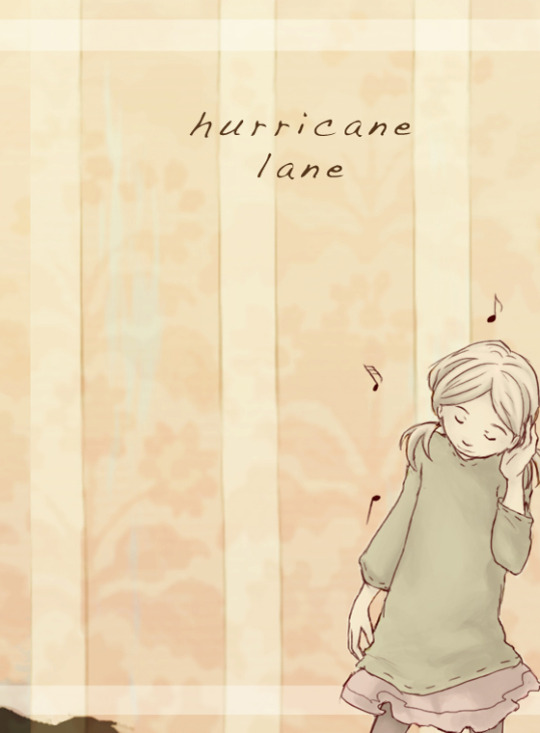

The number one thing I'm worried about is people thinking my book is related to the hurricane of the same name. I wrote this in 2010-2011 which predates it and the title is meant to convey Amelia's life in her suburban town and how she views it more dramatically then it is.
The name was also inspired by this beautiful song by The Hush Sound which I was listening to a lot whilst concepting and really influenced aesthetics (more subdued colour, the inclusion of the piano being an important story point etc).
I started getting interested in children's illustration when I saw the Penguin Design Competition advertised at my uni in 2010. I didn't make the cut but figured I'd go ahead and finish my book anyway because at that point I was invested in my story and wanted to complete it.
The contest called for an ebook with interactive pages so I made Hurricane Lane have seven special pages of 'wonders' Amelia finds throughout her story. Unfortunately with flash player gone the interactions don't play but they're still found online here;


I based Amelia's design on a Mii I had made which was supposed to represent a human Pikachu. You can see the Mii on the bottom left here. I really liked how it looked and she gradually evolved into what she is today.

Initially the dinosaur suit that her brother has was going to be worn by Amelia but I preferred her without it and thus Bailey was born. The dinosaur itself was based on a purple stegosaurus keyring I had when I was younger and loved even though I had no keys at the time.
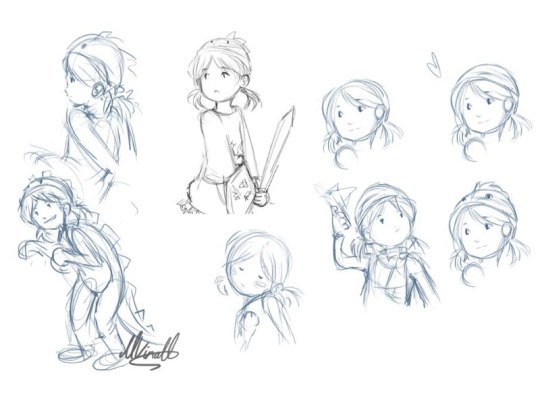
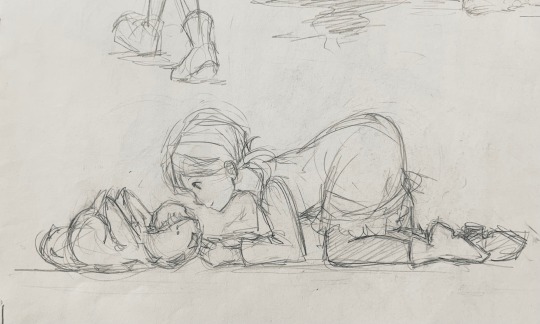
Here are some more initial outfit designs for Amelia but in the end I went with the one on the right, inspired by Miku Hatsune's 'Out and About' module from Project Diva.
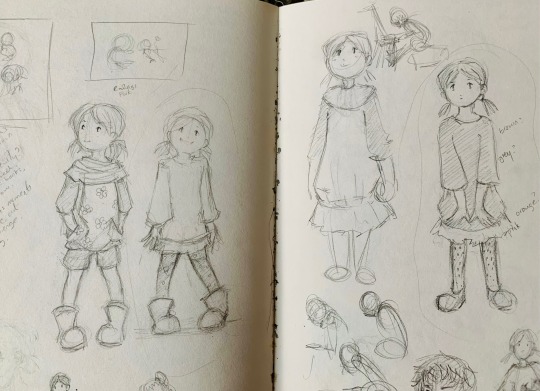

The family's father Rupert was partly based on my own dad (definitely the dress sense) but in 2010 I was also really obsessed with the BBC show Merlin and may have tried to age up Colin Morgan a bit to make this character.
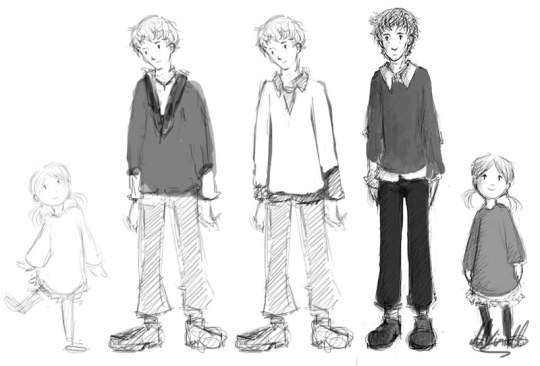

The mother's design was a little based on my own Mother's and a little the title character of the film Amelié (she evolved beyond this quite early so there's not too striking a resemblence). I was also obsessed with the music in that film which inspired this book a lot.
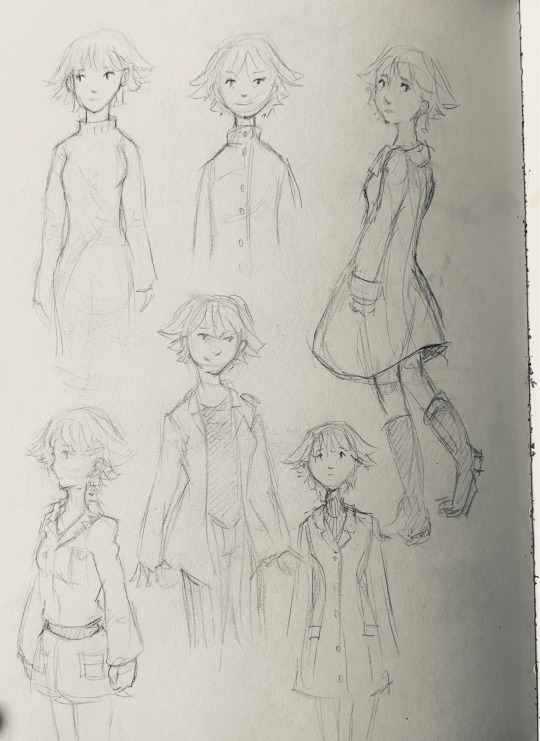
I kept it vague whether she worked at the hospital or was staying there as a patient because at the time I had an idea for an overarching narrative where the families of Hurricane Lane and 256 Postcards Ago meet. This didn't pan out so feel free to have your own interpretation.
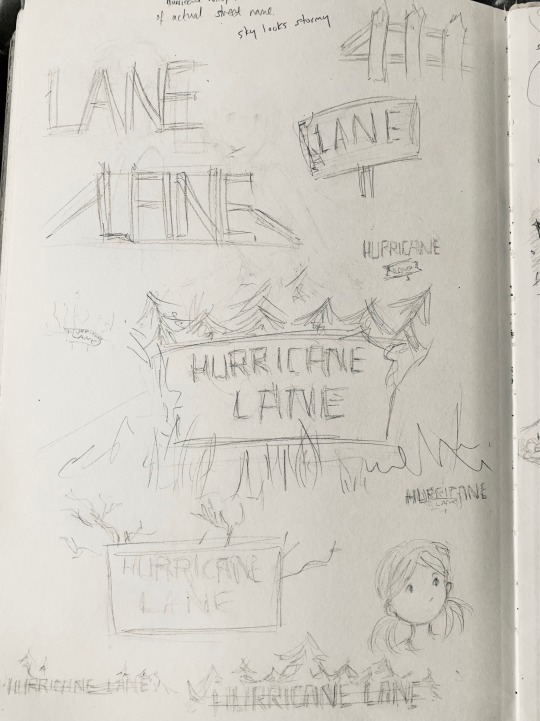
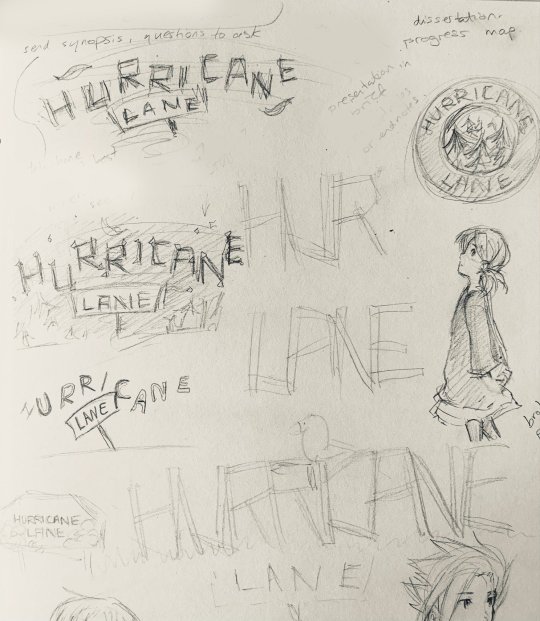
Here's some initial concepts of the logo which I was mostly scribbling during my Uni classes.
One more random tidbit is that I based the background of their journey home from the Toad's Turnpike track in Mario Kart 64. I really loved that game and it holds a lot of childhood memories for me so the nostalgia felt fitting. Maybe that's too weird to mention!


Towards the end I was concepting the protagonists of Hurricane Lane and 256 Postcards Ago meeting in a connecting rpgmaker game but sadly that never came to be. I'll talk about it more in my thread for the next book though!
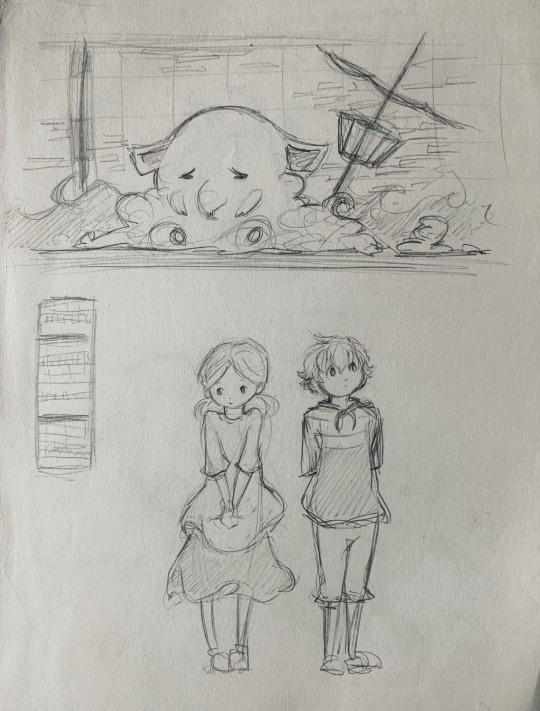

I also made a little soundtrack for my book here
1) Kiara
2) Cornflake Girl
3) Indaco
4) La Valse D'Amelie
5) 春よ、来い (kites)
6) The Heart Asks Pleasure First
7) Lotus (dragon hunters)
8) Nightbook
9) Reverie
10) Hurricane
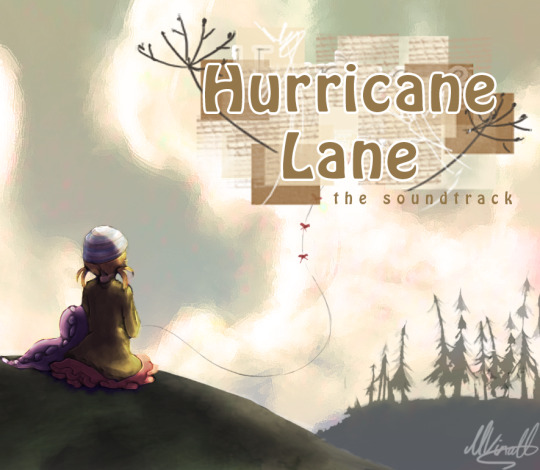
I listened to these songs a lot while reading and the final track inspired the title.
And final last tidbit- Hurricane Lane takes place in my childhood hometown. It doesn't have too many standout locations but I took photos for background references and anyone who lives there may recognize the small nods to it.
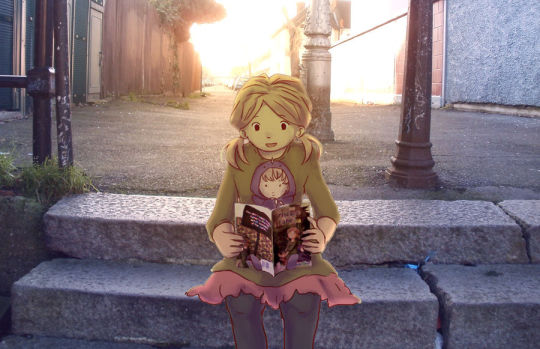
(Almost forgot links to where you can read my book)
Amazon paperback; https://amazon.com/dp/1475009097
eBook; https://frayedsymphony.gumroad.com/l/LuNug
Thanks for reading!
#myart#childrens book#picture book#hurricane lane#indie authors#kid lit#ocs#lore dump#i know no one cares#but i really dont want to lose these threads
19 notes
·
View notes
Text
Lead Generation for Service-Based Businesses: Tailoring Strategies for Success
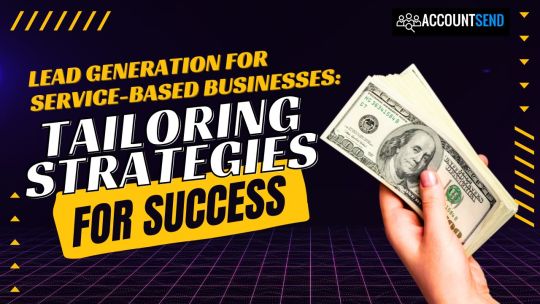
In the dynamic realm of service-based businesses, the art of lead generation has evolved into an indispensable cornerstone of success. Whether you helm a consultancy firm or curate a haven of beauty within the salon industry, the capability to captivate, engage, and convert potential clients has become the driving force behind growth. This comprehensive guide meticulously dissects ten meticulously crafted strategies, each an essential thread woven into the fabric of a comprehensive B2B lead generation strategy that seamlessly aligns with your industry and audience. From delving into the intricacies of your audience's unique needs to crafting resonant value propositions, from erecting a commanding online presence to harnessing the dynamic potential of content marketing, each dimension of this journey is explored in detail, leaving you armed with the knowledge and strategies needed to chart a course of sustainable growth and triumph.
DOWNLOAD THE INFOGRAPHIC HERE
Understanding Your Audience: Forging Bonds through Value-Centric Approaches
The expedition towards effective lead generation commences with a profound understanding of your target audience. Immersing yourself in their pain points, aspirations, and hurdles becomes the bedrock for fostering meaningful connections. By resonating with their distinctive challenges and offering tailored solutions, you're not merely initiating transactions; you're nurturing bonds founded on trust and empathy.
Developing a Solid Online Presence: Beyond Aesthetics and Visibility
In the digital epoch, your online presence stands as the gateway to your business's essence. Crafting a visually captivating website that harmoniously integrates with search engine optimization is no longer an option; it's a strategic necessity. A meticulously optimized website amplifies your online footprint, ensuring potential leads can effortlessly locate you amid the virtual cacophony.
Leveraging Content Marketing: Empowerment through Dissemination of Knowledge
Content marketing has emerged as a bedrock within the realm of lead generation. It emerges in myriad forms, from insightful blog posts that dissect industry intricacies to comprehensive ebooks that serve as navigational compasses through business challenges. The creation of valuable content propels you into the role of an authoritative figure. By addressing the nuanced pain points of your audience, you're not just beckoning their attention; you're fostering trust and credibility.
Offering Free Consultations or Trials: Inviting Experiences of Excellence
The influence of experiential engagement in lead conversion is profound. Extending the gesture of free consultations or trials offers potential clients the opportunity to immerse themselves in your services without obligation. This tangible involvement diminishes barriers to entry and showcases the tangible value they stand to gain, nurturing trust and accelerating conversion.
Utilizing Social Media Platforms: Strategic Engagement Unveiled
The tapestry of social media is diverse, with platforms catering to distinct demographics and preferences. Pinpointing the platforms your target audience gravitates toward is a strategic art. Engaging them through informative content, industry insights, and behind-the-scenes peeks cultivates genuine interactions, seamlessly guiding them toward your lead generation funnel.
youtube
Running Targeted Email Marketing Campaigns: Precision in Direct Communication
Amidst the myriad communication channels, email marketing remains an enduring asset. Tailored email campaigns curate a nurturing environment for leads through personalized content and pertinent information. Designing emails that fluidly adapt to mobile devices guarantees your messages resonate, fostering interaction and ultimately conversion.
Encouraging Customer Reviews and Testimonials: The Sway of Social Proof
In an era where trust shapes decisions, customer reviews and testimonials wield substantial influence. Positive reviews act as tangible social proof, validating the caliber and authenticity of your services. These testimonials resonate with potential clients, offering a glimpse into the experiences of their peers and significantly influencing their decision-making journey.
Implementing a Referral Program: Harnessing Organic Advocacy
Tapping into the organic power of word-of-mouth advocacy via a meticulously designed referral program is transformative. Encouraging satisfied clients to advocate for your services within their network, incentivizing their efforts with discounts or exclusive perks, ushers in an era of amplified reach and engenders loyalty-driven organic growth.
Collaborating with Complementary Businesses: Synergy in Collective Growth
Collaborations with businesses offering complementary services herald fresh avenues for lead generation. These symbiotic partnerships introduce your brand to a wider audience segment that may be in need of your services. The symphony of collaboration nurtures both entities, augmenting exposure and fostering a sense of shared vision.
Optimizing Your CRM Integration: Streamlined Lead Management
Integrating your lead generation endeavors with a robust Customer Relationship Management (CRM) system refines lead management dynamics. This integration enhances follow-up efficiency, meticulously maintains comprehensive interaction records, and elevates conversion rates. With a seamlessly optimized CRM integration, your team is empowered to meticulously nurture leads and navigate them through a smooth conversion journey.
Embarking upon the lead generation odyssey for service-based businesses mandates strategic insight, adaptability, and innovation. By seamlessly weaving these meticulously tailored strategies into your approach, you're not merely generating leads; you're nurturing relationships, delivering value, and architecting a narrative of excellence. Remember, this is a perpetual voyage of
growth, an ongoing process of evolution and refinement. By infusing these insights into your lead generation efforts, you're not simply propelling sales; you're molding the trajectory of your business toward sustained success.
#AccountSend#B2BLeadGeneration#B2B#LeadGeneration#B2BSales#SalesLeads#B2BDatabases#BusinessDevelopment#SalesFunnel#SalesProspecting#BusinessOwner#Youtube
16 notes
·
View notes
Text
Patreon Changes
Hi! Now that I'm almost a month into this experiment, I've decided to make a few changes to my Patreon tiers.
(This shouldn't be a negative change for any of my current patrons, don't worry!)
When I first started all this, I was sort of thinking to myself "oh, the lowest tier is sort of a tip tier, I shouldn't put too many benefits in there" and "wow, $5 is so much to ask, just the historical blogs aren't worth that, I should put writer commentary in that tier!"
But as I continue, I realize that there's a lot of writer commentary (specifically things about how I designed the way the characters and settings look) that I wanted all of my readers to be able to access. So I put those on the free tier.
I've also come to realize that $5 a month for like 5-10 short historical articles isn't that much to ask. It's probably going to be 5k-15k words of additional content each month, plus illustrative photos. While hip-deep in some really dense books about the origins of Daidalos, I realized that I may be underselling my own time and research here. Even if most of this information can be found in a few books, the time it takes to read those books and summarize the information isn't worthless.
So I've decided to make my writer commentary more accessible and let the historical blogs stand on their own.
Going forward, all writer commentary will be available to my Wanderers ($2 tier) and not just my Explorers ($5 tier). The free tier and tiers above $5 will be unchanged.
I'm going to be posting some more writer commentary tonight, as well as a post about Daidalos (talk about a freaking labyrinth full of yarn to untangle), and I'm going to go back to my older writer commentary and make that available to Explorers.
So to be clear now:
Free tier: basic commentary on character designs, announcements
Wanderer ($2): early chapters, writer commentary
Explorer ($5): historical blog posts
Adventurer ($7): additional supplemental scenes
Hero ($10): free ebook access once it is released
Plus, obviously, everything that previous tiers have access to.
Also, an announcement for Adventurers: now that both of the main characters have been introduced, supplemental scenes will start soon. There are four stories total and they'll be popping up roughly once a month.
Finally, one more announcement! I got a couple people asking if the book would be made available in hard copy. I was initially hesitant, but I've found some services online that should make that doable. Once the story is complete, I'll put out some interest surveys to figure out which option would be best.
Anyway, thank you to everyone who's supported me thus far, whether by reading, commenting, reblogging, or becoming a Patron. I appreciate all of you very much. 💜
#Once I get chapter 5 on AO3 tomorrow#I'm considering... actually blazing a post on tumblr...#it feels a little silly to do that if I'm being real with you but idk man I really want people to read this one#it's become so dear to my heart#aitnists#housekeeping
3 notes
·
View notes
Text
What is PLR Products
PLR Products: What They Are and How They Can Benefit Your Business

Hey there! Have you ever come across the term "PLR products" and wondered what it actually means? Well, you're not alone. In the world of digital marketing and online businesses, PLR products are a hot topic. In this article, we'll dive into the ins and outs of PLR products—what they are, how they work, and why they're so popular among entrepreneurs. So grab a cup of coffee and get ready to learn all about this exciting aspect of the online business world!
What are PLR Products?
Understanding PLR Products
Individuals or businesses can purchase and use PLR products, or Private Label Rights products, for their own purposes. This includes articles, ebooks, graphics, software, and more.
Benefits of Using PLR Products
Save time and effort by creating content from scratch
Cost-effective compared to hiring a writer or designer
Customize the content to fit your brand's voice and style
Whether you're looking to fill your website with valuable information or create lead magnets for your email marketing campaigns, PLR products offer a convenient solution for busy professionals.
Understanding the Rights of PLR Products
PLR licenses exist on a spectrum, each granting different levels of usage and modification rights:
Private Label Rights (PLR):
This is the most comprehensive license. Buyers can edit, modify, and rebrand the content as their own. They can sell it, give it away, bundle it with other products, or use it as a lead magnet. Essentially, they have full control over the content's usage.
Resell Rights (RR):
With Resell Rights, buyers can sell the product as-is, but they cannot modify the content. They can package it with other products or use it as a bonus, but they cannot claim authorship.
Master Resell Rights (MRR):
Similar to Resell Rights, but with one key difference: buyers can also grant Resell Rights to their customers. This means they can sell the product and allow their customers to resell it as well.
Giveaway Rights:
This license allows buyers to give away the product for free. They can use it as a lead magnet, offer it as a bonus, or include it in a free membership. They cannot, however, sell the product.
Personal Use Rights (PUR):
This is the most restrictive license. Buyers may only use the product for personal purposes. They cannot modify, sell, or give it away.
Important Considerations for Entrepreneurs:
Read the License Agreement: Each PLR product is accompanied by a license agreement that outlines the specific rights granted. It's crucial for entrepreneurs to read and understand these terms before purchasing or using any PLR content.
Choose the Right License: Before making a purchase, consider how you intend to use the PLR product. Do you want to sell it, give it away, or use it for personal use? Choose the license that best aligns with your goals.
Respect Copyright Laws: While PLR grants certain rights, it's important to remember that copyright laws still apply. Always give credit to the original author where required, and avoid any unauthorized use of the content.
Add Your Unique Touch: Even with PLR, adding your unique voice, branding, and expertise can make the content truly yours and help it stand out in the market.
By understanding the different types of PLR rights and choosing the right license for their needs, entrepreneurs can leverage the power of PLR to create valuable content, save time and resources, and grow their businesses effectively.
Benefits of Using PLR Products

Time-saving: PLR products offer ready-made content that you can quickly customize to meet your needs, saving you valuable time and effort compared to creating content from scratch.
Cost-effective: Purchasing PLR products is often more affordable than hiring a professional writer or designer to create custom content for your business.
Flexibility: With PLR products, you have the freedom to edit, customize, and rebrand the content as much as you like to make it unique to your brand.
How to Use PLR Products in Your Business
Make necessary edits: To make the PLR products unique to your business, customize them with your branding and voice.
Create valuable content: Use PLR articles, ebooks, and courses as a base for creating new content that provides value to your audience.
Offer incentives: Use PLR reports or templates as lead magnets to grow your email list and attract potential customers.
By following these simple steps, you can effectively incorporate PLR products into your business strategy and maximize their benefits while saving time and money on content creation. Remember to always stamp your own materials before sharing them with your audience for a personalized touch that sets you apart from competitors.
Common Myths and Misconceptions about PLR Products
Myth 1: All PLR products are low quality. While some PLR products may be of inferior quality, there are also many high-quality PLR resources available. It's essential to research and choose reputable sources for your PLR content.
Myth 2: You can't customize PLR products. Contrary to popular belief, you can edit, modify, and personalize PLR products to fit your brand or target audience. This flexibility allows you to create unique content that aligns with your specific needs.
Myth 3: Using PLR content is plagiarism. As long as you follow the licensing terms provided by the creator of the PLR product, using it in your own work is completely legal and ethical. Just make sure to review the usage rights included with the product before incorporating it into your projects.
Tips for Finding High-Quality PLR Products
Look for reputable sources: When searching for PLR products, make sure to only buy from trusted and well-known PLR websites. This will help ensure that you are getting high-quality content that is worth investing in.
Check the license agreement: Before purchasing any PLR product, carefully read through the license agreement to understand what rights you have with the content. Make sure it allows you to modify, brand, and sell the product as your own.
Review samples before buying: Many sites offer free samples of their PLR products. Take advantage of this by reviewing a sample to assess the content's quality before making a purchase.
How to Customize and Brand PLR Products

Customizing and Branding PLR Products
Edit the Content: To customize PLR products, the first step is to edit the content.This can include changing text, images, and formatting to match your brand's style and voice.
Add Your Logo: To further brand PLR products, consider adding your logo or watermark to any images included in the product. This will help reinforce your brand identity.
Create Packaging: Finally, package the customized PLR product with additional materials, such as a branded cover or bonus resources, to create a cohesive and professional look for your audience.
Remember that when using PLR products, customization is key to ensuring they align effectively with your brand values and messaging.
Legal Considerations When Using PLR Products
Rights and restrictions: Be aware of the terms outlined in the PLR license agreement, which dictate how you can use the content. Ensure that you are following these guidelines to avoid any legal issues.
Attribution: Some PLR products require you to give credit to the original creator when using their content. If the license agreement specifies this requirement, make sure to comply.
Modification: Before using the PLR products for your own purposes, check that you have permission to modify or customize them.Violating any such restrictions could result in legal repercussions.
Understanding and adhering to these legal considerations allows you to use PLR products ethically and within the boundaries set by their creators. It's vital to respect intellectual property rights and abide by licensing agreements when utilizing these pre-made resources for your projects or business needs.
Strategies for Monetizing PLR Products

Rebrand and Customize: One strategy to monetize PLR products is to rebrand them with your own logo, colors, and branding. This will make the product feel unique to your audience and increase its perceived value.
Create Upsells and Bundles: Another effective strategy is to create upsell offers or bundles with complementary products. This can help you maximize revenue by offering additional value to customers who have already purchased a PLR product from you.
Offer Licensing Options: Consider offering different licensing options for your PLR products, such as personal use, resell rights, or private label rights. This provides flexibility for customers and allows you to earn more depending on how they intend to use the product.
Should You Use PLR Products in Your Online Business?
Save Time and Effort: Using PLR products can save you time and effort when creating content from scratch.
Cost-Effective Solution: Purchasing PLR products is a cost-effective way to get high-quality content for your online business.
Customization Options: When using PLR products, remember to customize them to fit your brand and audience for better results.
Quality Control: Always ensure that the PLR products you purchase are of excellent quality and relevance before using them in your online business.
Avoid Duplicate Content: Be cautious not to use the same PLR product as other businesses, as it may dilute your unique brand voice.
In conclusion, leveraging PLR products in your online business can be beneficial if used wisely with proper customization and attention to quality control practices. For more tips and guides and how to earn with PLR, follow our blog on Tumblr.
3 notes
·
View notes
Text
#48 - How to Strengthen Your Self Love & Spiritual Connection
If you've struggled to accept yourself and love yourself, and you've found this whole notion of "self love" confusing... like - what does that mean? How do I actually do that? I try to be loving to myself but I just don't feel love for myself. This episode is for you.
AND if you're also on a spiritual path and have wanted to deepen your spiritual connection... then doubly pay attention to our guest in the episode Dr Margaret Paul. Your self love and spiritual connection are deeply related!
This is a brilliant session for understanding what it actually means to strengthen both self love and spiritual connection, and WHY we have a lack of these in the first place!
Free Gifts from Dr Margaret Paul
Free eBook - The 6 Reasons Why Loving Yourself is Essential for Inner Peace, Joy, and Loving Relationships
https://innerbondinghub.com/reasons/
Free Webinar - 3 Secrets to Loving Yourself and Others
https://innerbondingwebinar.com/
Other Resources
Get Dr Margaret's latest book "Lonely No More":
https://innerbondinghub.com/checkouts/lnm-checkout/
Start the Inner Bonding Online Course:
https://innerbondinghub.com/sp/ib-join-2023/
About Dr Margaret Paul
Dr. Margaret Paul is a bestselling author, popular MindBodyGreen writer and co-creator of the powerful Inner Bonding® self-healing process (www.innerbonding.com), and the related SelfQuest® self-healing online program – recommended by authors Marci Shimoff and Dr. Sue Morter, actress Lindsay Wagner and singer Alanis Morissette.She has appeared on numerous radio and television shows (including Oprah). Her book titles include Do I Have to Give Up Me to Be Loved By You (and subsequent titles Do I Have to Give Up Me to Be Loved By God, and …By My Kids), Healing Your Aloneness and Inner Bonding, and the recently published, Diet For Divine Connection and The Inner Bonding Workbook.Margaret holds a PhD in psychology, is a relationship expert, public speaker, consultant and artist. She has successfully worked with thousands and taught classes and seminars for over 50 years.
Margaret lives in Colorado on a 35-acre ranch. She has three children and three grandchildren. In her spare time, she loves to paint, cook delicious healthy food, read, make pottery, and joyously live her life as a Golden Girl with her best friend.Margaret is a member of the Transformational Leadership council started by Jack Canfield.
RESOURCES & COACHING WITH B
FREE MASTERCLASS: 3 Steps to Designing Your Soul Aligned Life
https://www.bernadettelogue.com/design-your-aligned-life-webinar-4/
FREE GUIDE: Soul Answers
https://www.bernadettelogue.com/soul-answers-free-guide/
BOOK: Your Soul Journey Simplified
https://www.bernadettelogue.com/soul-book/
PROGRAM: Soul Odyssey Program with Live Support & Community
https://www.bernadettelogue.com/soul-odyssey/
PRIVATE MENTORING: Join me for 1:1 Spiritual Life Coaching. Visit:
https://www.bernadettelogue.com/spiritual-life-coaching-mentoring/
CONTACT:
Email: [email protected]
IG: https://instagram.com/bernadette_logue_
Facebook: https://www.facebook.com/BernadetteLogueCoach
Youtube: https://youtube.com/channel/UCc0aZECdd7ln-A6-U4f14tg
Checkout the new Practical Spirituality podcast episode!
#podcast#spirituality#soul#purpose#happiness#self help#spiritual#life purpose#soul purpose#life coach#inner peace#empowerment
4 notes
·
View notes
Text
I was asked privately about the process of publishing a book, but I thought I'd repeat the answer in public in case it's useful for anyone else.
There are two main routes to publishing fiction. Both require that the manuscript be completely finished and polished to a shine before you do anything else, so I'd recommend getting at least three or four beta editors looking at it and getting it as refined as possible.
Route 1: Traditional publishing:
Once the work itself is completely finished, the first (and most important step) is to get yourself an agent. Precious few publishing houses will accept submissions from an unagented writer.
In order to snag an agent, you have to write (and then refine) a query letter and synopsis of your work, and submit it to an agent. Submitting a query is more or less like submitting an application to a potential place of employment, with the hopes that the person will give you an interview, with the hopes that that person will okay you to get a second interview, with the hopes that that person will actually give you the job. Each step weeds out people who aren't quite the right fit for one reason or another.
You can find lists of agents online, but the websites I used while querying were https://www.agentquery.com, querytracker, and I learned a ton reading through the archives at QueryShark.
When submitting to an agent, read each agent's profile carefully. If you submit a genre or vibe that they don't represent, or you don't address the email as instructed, you're disqualifying yourself out of hand. A very small percentage of agents will actually send rejection emails, an even smaller percentage will request a follow-up (a synopsis, the first couple of chapters of your manuscript, etc). Don't get discouraged if it takes a long time. Some agents will offer feedback on your submission. Often this is good advice, but it isn't always, so read it carefully and think on it before doing anything with it.
This is the only part of the process that's actually in your control. From that point forward, your agent will submit your work to publishing houses and negotiate a contract, and they'll guide you from there.
Route 2: Self Publishing
Some books don't work in a traditional market for one reason or another, or their authors just prefer to have more control over the process. Keep in mind, while the bar to entry for self publishing is very low, doing it well can be significantly more difficult and expensive.
Among the things that a self-published author will need to shell out for that a publisher usually pays for:
Editing. An editor to make sure that the quality of the book is up to par. These can be both for content and for line edits, and it's important to check.
Formatting. This is how the text looks on the page, and it's a lot more complicated than you would assume. I actually recommend using draft2digital to do the formatting for your digital files, because otherwise it is a nightmare. For print files, I'm told Scribus is solid free software, but I haven't yet used it myself. But trust me, a badly formatted file is a quick way to turn off readers.
Cover art. You can search cover artists online, or if you have a story that it works for, you can buy premade cover art at places like The Book Cover Designer and. Pay careful attention to how they look as thumbnails-- keep in mind that ebooks are frequently purchased through a phone or tablet, so the cover has to look good when it's tiny as well as in large scale. Another tip: pay close attention to the fonts, too. If a book cover looks slightly off and you can't quite place why, it's probably the font. You can frequently request that a premade cover change the font for free if you don't like it. A bad book cover is also a quick way to turn off potential readers.
Advertising. Yes, absolutely all the advertising is on your shoulders with this one. It takes a lot to figure out what works for you, your skillset, and your book. For me, I've found that I sell best at nerd-centered events like comic conventions and such, because I sell fantasy books. I don't recommend "all genre book events" unless you're selling cozy mystery or romance.
Printing and distribution. I use Ingram for printing, and I use Amazon and Draft2Digital for my digital sales. Draft2Digital allows you to sell to a variety of online markets, Amazon only allows you to sell to its own, but it's the biggest one out there. The latter two are free, while Ingram requires that you pay per file you upload. Ingram is also less user friendly, but I like the quality better, and it allows the books to be purchased by bookstores if somebody makes the request.
ISBNs. Amazon provides its own for free, but you can only use that in limited markets (namely, theirs and a small number of others). Depending on what platform you use to sell, you'll have to purchase an ISBN. DO NOT DO IT BY YOURSELF IF YOU CAN HELP IT. Because the way it's structured (to advantage Big Publishers and disadvantage self-pubbed writers), a single ISBN costs $125, buying 10 at once costs just under $30 each, and buying 100 costs just under $6 each. Yes, it is bullshit. I joined a writing group in my area, and we pooled our money and bought 100 ISBNs in bulk.
I hope that this is helpful to you, and I wish you luck with your writing!
66 notes
·
View notes